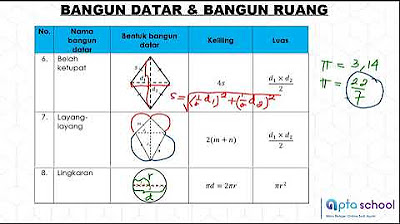Quadrilaterals - Trapezoids, Parallelograms, Rectangles, Squares, and Rhombuses!
Summary
TLDRThis video tutorial covers the fundamentals of quadrilaterals, explaining the properties of different types like trapezoids, parallelograms, rectangles, rhombuses, and squares. It emphasizes the key concept that the sum of interior angles of any quadrilateral is always 360°. The video also walks through practical algebraic methods for solving for unknown angles in quadrilaterals, demonstrating step-by-step examples. Additionally, viewers are introduced to an algebra course on Udemy, offering further learning on topics like linear equations, quadratic functions, and graphing. The goal is to help students strengthen their understanding of both geometry and algebra.
Takeaways
- 😀 A quadrilateral is a four-sided polygon, and the sum of its interior angles always equals 360°.
- 😀 Trapezoids have one pair of parallel sides. In an isosceles trapezoid, the non-parallel sides are congruent, and the angles opposite them are congruent.
- 😀 A parallelogram has two pairs of parallel sides, with opposite sides also congruent.
- 😀 In a rectangle, all four angles are right angles (90°), and opposite sides are both congruent and parallel.
- 😀 A rhombus has four congruent sides, and its diagonals intersect at right angles.
- 😀 A square is both a rhombus and a rectangle. All four sides are congruent, and all angles are 90°.
- 😀 The sum of the angles in any quadrilateral is 360°. This rule is essential for solving problems involving missing angles.
- 😀 To solve for a missing angle in a quadrilateral, subtract the sum of the known angles from 360°.
- 😀 When solving algebraic expressions for angles in a quadrilateral, combine like terms and solve for the unknown variable.
- 😀 To find an unknown angle using an algebraic expression, substitute the value of the variable once it's solved, and calculate the angle value.
Q & A
What is a quadrilateral?
-A quadrilateral is a four-sided polygon. The sum of the interior angles of any quadrilateral is always 360°.
What is the key property of a trapezoid?
-In a trapezoid, one pair of opposite sides are parallel. If it is an isosceles trapezoid, the non-parallel sides are congruent, and the angles opposite to those sides are also congruent.
What is a parallelogram and its key properties?
-A parallelogram is a quadrilateral where opposite sides are parallel and congruent. This means that both pairs of opposite sides are equal in length and parallel.
How does a rectangle differ from a parallelogram?
-A rectangle is a type of parallelogram where all four angles are 90° (right angles). While opposite sides are still parallel and congruent, the key difference is the presence of right angles in a rectangle.
What is a rhombus, and what are its key features?
-A rhombus is a quadrilateral where all four sides are congruent. The diagonals of a rhombus bisect each other at right angles (90°).
How is a square different from a rhombus and a rectangle?
-A square is a special case of both a rhombus and a rectangle. It has all four sides congruent like a rhombus, and all four angles are right angles like a rectangle. In addition, opposite sides are parallel.
How can you find the value of a missing angle in a quadrilateral?
-To find a missing angle in a quadrilateral, you can use the fact that the sum of all interior angles in a quadrilateral equals 360°. Subtract the sum of the known angles from 360° to find the value of the missing angle.
In the example problem, what is the value of the missing angle 'x'?
-In the example, the angles 58°, 73°, and 117° add up to 248°. Subtracting this from 360° gives 112°, which is the value of the missing angle 'x'.
How do you solve for the missing angle when the angle expressions are in terms of 'x'?
-To solve for the missing angle when the angle expressions contain variables, set up an equation where the sum of all angles equals 360°. Combine like terms and solve for 'x'. Once you have 'x', substitute it into the angle expression to find the exact angle.
What algebra topics are covered in the recommended Udemy algebra course?
-The Udemy algebra course covers a wide range of topics, including basic arithmetic, fractions, linear equations, inequalities, polynomials, systems of equations, quadratic equations, rational expressions, radical expressions, and more. It also includes video quizzes to reinforce learning.
Outlines

此内容仅限付费用户访问。 请升级后访问。
立即升级Mindmap

此内容仅限付费用户访问。 请升级后访问。
立即升级Keywords

此内容仅限付费用户访问。 请升级后访问。
立即升级Highlights

此内容仅限付费用户访问。 请升级后访问。
立即升级Transcripts

此内容仅限付费用户访问。 请升级后访问。
立即升级浏览更多相关视频

CLASSIFICATION OF QUADRILATERALS || GRADE 9 MATHEMATICS Q3

Luas dan keliling bangun datar (Lengkap Semua bangun datar)

Types of Quadrilaterals and Other Polygons

Jenis -Jenis dan Sifat - Sifat Segi Empat | Matematika SMP/MTs Kelas 7

MATERI BANGUN DATAR DAN RUANG

Area of a Rectangle, Triangle, Circle & Sector, Trapezoid, Square, Parallelogram, Rhombus, Geometry
5.0 / 5 (0 votes)
